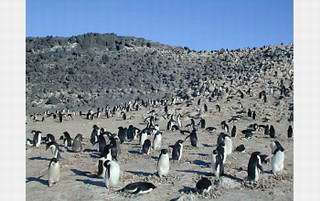August 9, 2012 report
Biologists take journalists to task for sensationalizing animal sexual behavior headlines

(Phys.org) -- Andrew Barron and Mark Brown of Macquarie University, Sydney and Royal Holloway University of London, respectively, have a bone to pick with those who resort to tabloid sensationalism when creating headlines and indeed entire articles when writing for science journals and magazines, as they attempt to describe the sexual behavior of animals. In their commentary piece published in the journal Nature, they say that the media too often resorts to ascribing human sexuality terms to animals especially regarding atypical sexual relationships which can in some cases have negative connotations.
The two appear to be most concerned about authors and/or editors that use human terms to describe homosexual relationships between animals, describing them as gay, lesbian or in some cases transgender, when such terms are not just inaccurate, but are in some cases outright wrong. To bolster their case, they include a chart that lists actual titles or phrases used in scientific study papers, and the various ways writers and editors have butchered the words to help increase magazine sales or increase traffic on web sites. One such example: “The Ram as a model for behavioral neuroendocrinology” became “Brokeback Mutton” or “Yep, They’re Gay.” While somewhat humorous, the changes create the illusion that the behaviors exhibited by the real life ram, are somehow the same as those of gay human beings, which is of course utter nonsense because with humans, human emotions are involved, while emotions in animals, if they even really do exist, are not understood at all. But that’s beside the point, the real issue here is journalistic integrity, or the lack of it.
If a writer is writing for a science magazine or web site, it’s imperative that he or she build a relationship with readers based on some degree of trust. Visitors come to such sites to learn something. If an author or editor resorts to tabloid headlines that distort what has been observed, they are violating that trust because their intent is no longer to inform, but to raise revenue. On the other hand, if the general media resort to such chicanery, it is assumed the public will understand that they are trying to be cute with their writing, though neither seems to care if the actual science behind the article ever emerges, which, as the two commentators point out, can lead to negative perceptions of the human beings that are being used for comparison. Reporting that an animal is engaging in gay or lesbian behavior in a sensationalistic way, for example, quite often comes across as an example of an aberration, which implies that there is something wrong with them, which in turn, implies that there is something wrong with humans that engage in same-sex relationships.
Barron and Brown conclude by suggesting that those in the media could be a little more careful in how they choose to represent animal sexual behavior.
More information: Science journalism: Let's talk about sex, Nature, 488, 151–152 (09 August 2012) doi:10.1038/488151a
Abstract
The media loves to sensationalize research on animal sexual behaviour — so be careful what you say, warn Andrew B. Barron and Mark J. F. Brown.
Journal information: Nature
© 2012 Phys.org
















